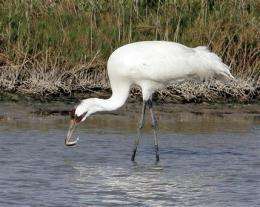FILE -In this Sunday, Jan. 15, 2006 file photo, a whooping crane eats a crab at the Aransas National Wildlife Refuge, near Rockport, Texas. More than 20 percent of the world's only naturally migrating flock of whooping cranes were lost and are presumed to have died from April 2008 to April 2009, according to the U.S. Fish and Wildlife Service. (AP Photo/Ron Heflin, File)
(AP) -- The world's only naturally migrating whooping cranes, and the species' best chance for survival, died at about twice their normal rate last year and will likely see an overall drop in their numbers, a worrying sign for the once near-extinct bird that has been making a comeback.
The whooping crane - the tallest bird in North America at 5 1/2 feet tall - numbered just 15 in 1941 but now numbers 539 and is considered a success story by conservationists.
There are three North American flocks but only one that migrates without human help, traveling every autumn from northern Canada to the Gulf Coast in Texas. Normally, about 10 percent of the flock dies off each year, but last year about 21 percent died off. Including new births, this year's flock is expected to drop by about 20 birds from last year's 270 when counted after returning to the Aransas National Wildlife Refuge this fall, said Tom Stehn, who oversees efforts to help the whooping crane for the U.S. Fish and Wildlife Service.
That would mark the first population decline for the flock since 2002.
"We're trying to figure out what's killing all these whooping cranes," Stehn said.
That flock typically grows by about six birds each year, but it dropped 19 birds between April 2008 to April 2009, as 57 of the flock's 266 birds died and were replaced by just 38 surviving hatchlings.
Hatchlings aren't counted in the total population until they have made it to Aransas, outside Corpus Christi, Texas. This year only 52 birds hatched to the flock - a six-year low - and only 22 of those survived, Stehn said.
"It's disappointing," he said. "It'll be interesting to see how it turns out this year."
The flock's population tends to dip about once each decade, but last year's spring decline was so sharp and unexpected it was "alarming," Stehn said.
Because the flock that migrates 2,400 miles from Wood Buffalo National Park in northern Canada's boreal forest to Aransas is the only self-sustaining flock, it is the species' best chance for survival, he said.
Whooping crane chicks from a flock in central Wisconsin are guided to Florida by ultralight aircraft. A third flock in central Florida that was heavily managed does not migrate and has not been reproducing.
"The species remains so very endangered, and the threats are rising," Stehn said.
It's difficult to know exactly how the birds die in part because they're not individually tracked and their 200-mile wide migration corridor is so large.
One likely cause for the population decline could be changes in habitat, Stehn said. A drought in Texas severely affected the whooping crane's foods of blue crabs and berries. Corn feeders were set up to supplement the cranes' diets, but only about half of them used the feeders. And wetlands and prairie have been making way for cornfields along parts of the flock's flyway, which runs from northern Canada through Montana and the Dakotas, New Mexico, Nebraska, Oklahoma and Kansas.
Birds are also threatened by disease, including infectious bursal disease, which was found in cranes in Florida in 2002 and again in one bird in the Aransas flock last year. Adult whooping cranes seem to be immune to West Nile virus, but there are concerns the disease could affect chicks.
Among efforts under way to understand the increase in whooping crane deaths is a plan to track about 20 of the Aransas birds using radio transmitters when they leave Texas next spring. Funding for a habitat conservation plan for the crane's migration corridor has also been approved, but work on the actual plan has yet to begin.
Mark Dumesnil, manager for the Nature Conservancy's Upper Gulf Coast program in Texas, said his organization recently acquired about 2,000 acres along the Texas coast, largely for whooping crane conservation.
"They are an icon species brought back from near extinction," Dumesnil said. "And, when you protect habitat for these birds, you protect habitat for a whole suite of species."
---
U.S. Fish & Wildlife whooping crane report:
©2009 The Associated Press. All rights reserved. This material may not be published, broadcast, rewritten or redistributed.


















